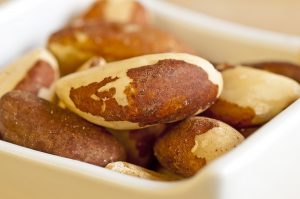You probably don?t think a lot about how much selenium you?re eating. Nor should you really if you?re living in America, where selenium deficiency is rare. Yesterday?s issue of Cancer Research Update will probably get you thinking about it a little.

Brazil nuts are loaded with selenium.
CRU highlights a new analysis on selenium intake and prostate cancer risk. The study was funded by the World Cancer Research Fund as part of AICR/WCRF?s Continuous Update Project (CUP).
Overall, the analysis found that increasing amounts of selenium ? up to a point ? reduce the risk of prostate cancer. We asked one of the study?s lead authors, Rachel Hurst, PhD, at the University of East Anglia, to help explain the findings.
Q: For blood concentration of selenium, you found risk decreased up to a point. Above that, what does the research show?
A: In our dose-response plots, the plasma/serum selenium concentration range went up to <175 ng/ml. We found decreased estimated relative risk of prostate cancer in the range between 135 and ~170 ng/ml. Other studies have shown no reduction in prostate cancer risk comparing selenium intake above a certain level. For example, taking 200 mcg/day? supplement on top of habitual intake in a selenium-replete population.
These studies together with the meta-analysis data suggest that there may be a narrow range of optimal selenium intake or selenium status (plasma/serum or toenail selenium) associated with a reduction in prostate cancer risk.
Q: The findings were ?more pronounced? for aggressive prostate cancer. Can you explain?
A: Yes, there was a greater reduction in the estimated relative risk for advanced prostate cancer when compared to the dose-response plot for the relationship between total prostate cancer. A plasma/serum selenium concentration of 135 ng/ml was associated with a 15 percent estimated reduction in total prostate cancer risk and a 40 percent reduction in advanced prostate cancer risk.
Q: Your analysis looked at three ?high quality? studies that measured selenium concentrations in people?s toenails. Why nails?
A: Toenail selenium is generally considered a good long term marker of selenium status and reflects tissue selenium status.
Q: For these three studies, the reduced risk was between 0.85 and 0.94 lg/g. How does this figure compare to having 170 ng/ml in blood?
A: If using one approach (Waters et al 2005) with the appropriate caveats considered, then toenail selenium of 0.85-1.00 mcg/g may compare to a plasma selenium concentration range of ~120 to 150 ng/ml.
Q: If a man is at increased risk of prostate cancer, would you recommend he get tested for selenium or should he concentrate on getting a healthy selenium level through his foods?
A: The research is still too early and further research is required [for testing]. We agree that it is most appropriate to obtain adequate selenium intake through diet, and not through supplements.
The recommended daily intake of selenium is 55 micrograms/day for most adults. (An egg has 15 mcg and a slice of whole wheat bread has 11 mcg. Brazil nuts top the chart with 544 mcg per ounce.) The Institute of Medicine set the upper level at 400 micrograms per day. To see how much selenium various foods have, visit here.
brown recluse front door alyssa bustamante protandim weightless ellen degeneres jcpenney yeardley love
No comments:
Post a Comment
Note: Only a member of this blog may post a comment.